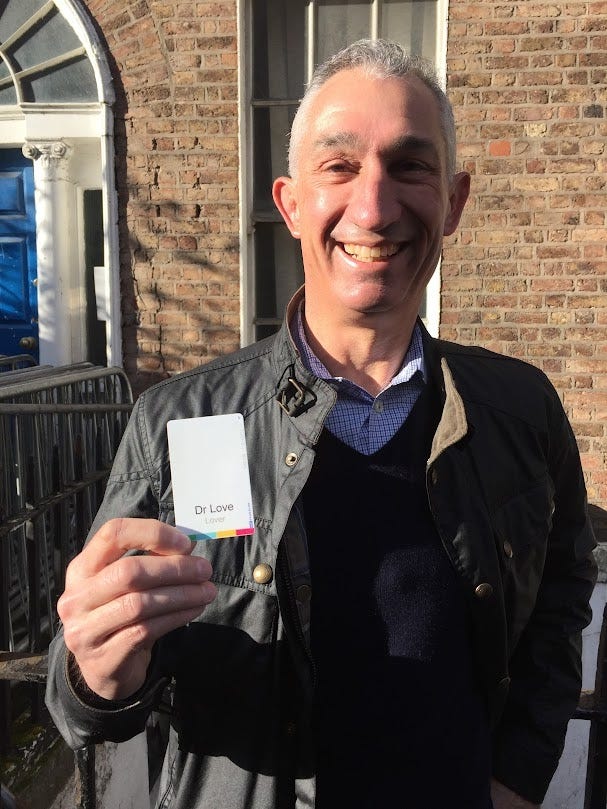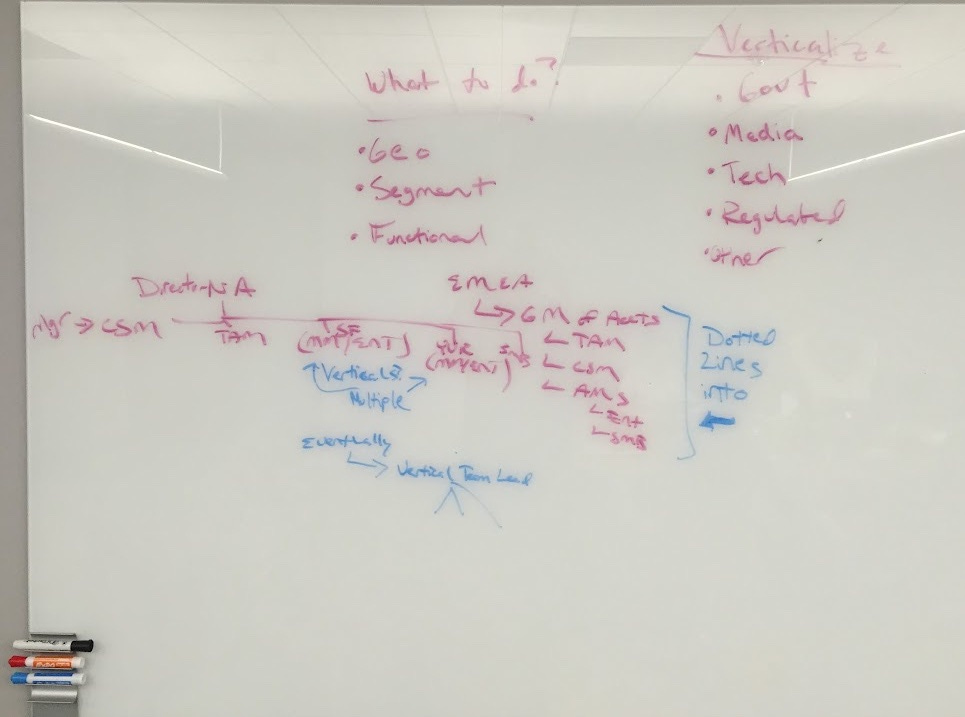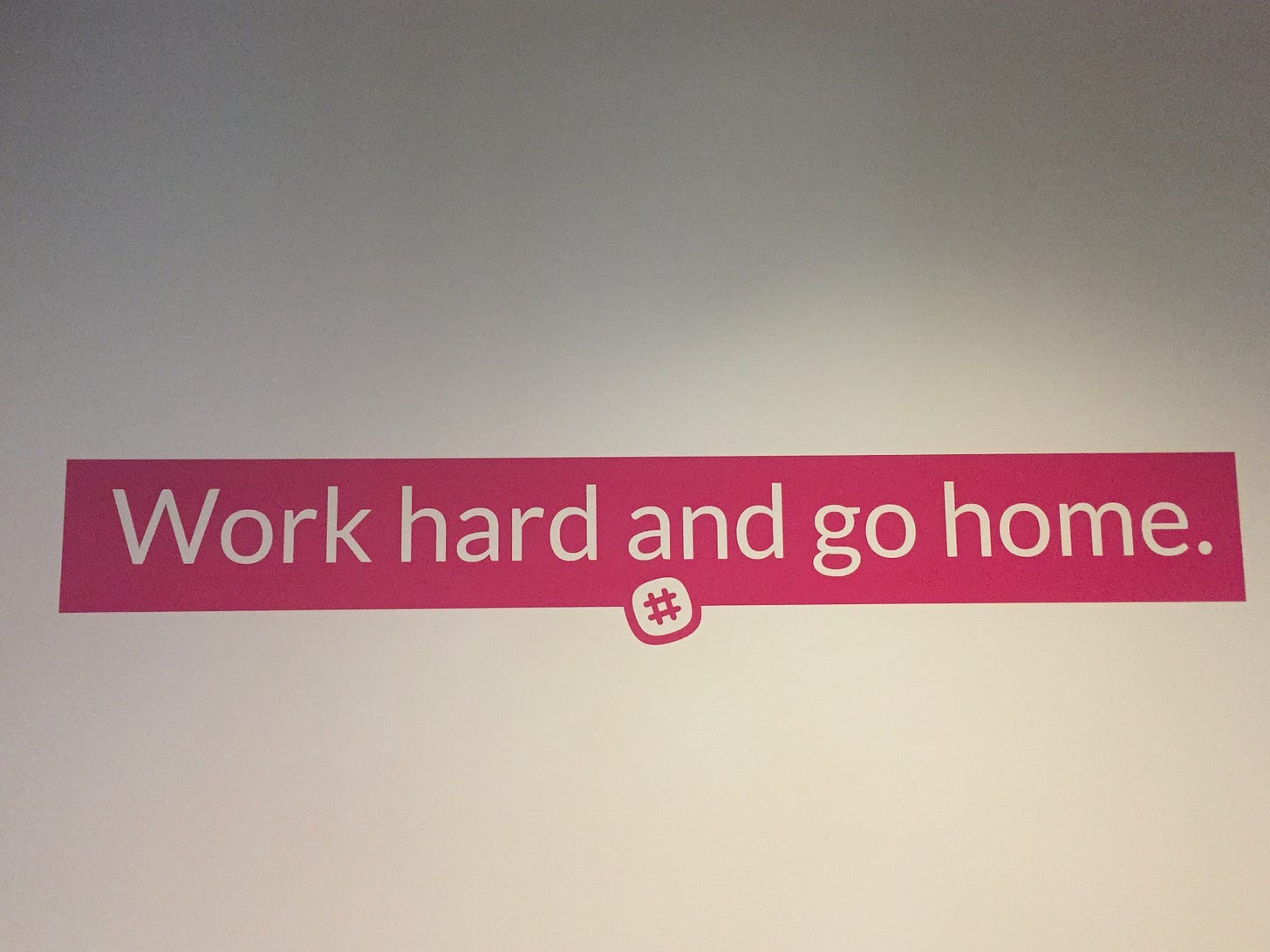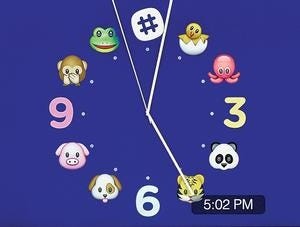Meet the New, New, New Boss
Feeling our teenage years. Finding a top-1 leader for growing Slack. Hiring our new boss.
“So, who are your top 3 candidates?”
This was Stewart, asking me for my opinion on the sales leadership candidates we had been interviewing. We had finally posted an opening for a VP of Sales at Slack. But the role felt like a hard one to fill. Let’s dig in to why.
First off, those of us leading Sales at Slack — myself and AJ — had to do a bit of pride swallowing and decide that we could not do the job. We didn’t have the experience. We didn’t have the skills or the vision or the capabilities. We covered that last chapter in Leaving Never Neverland.
Our pride swallowing completed, we decided we could see the bigger picture. We needed someone who’d done it before. We needed someone who could teach us. To get to this realization actually proved not too hard because as soon as we got into any specific detail of execution — Who were we going to hire next? Did we segment by industry, geography, customer size? How did our compensation plans need to change? — we could see we’d be quickly out of our depth. And now we got to hire our new boss. Great! But we didn’t come at the hiring job without our own respective ideas about what we needed.
Secondly, the Slack of 2016 was only 2 years into having a commercial product available and many parts of the organization still felt very development-driven. “Doesn’t the product just sell itself?” was a question I had answered many times to internal folks who saw the success of some of our product-led growth. Why did we need sales people?
Our CEO had even been quoted in the press saying no salespeople for us. So you could perhaps have the impression that Slack maybe didn’t feel totally sure that it even wanted to be in Sales. That would have been accurate. So we needed to do a bit of a sell on Sales internally. That effort happened in the midst of many coming-of-age efforts to evolve Slack into the company that could seize the opportunity we faced.
Is that a company you would have wanted to join?
Feeling Our Teenage Years
One of the phrases we used at the time to rally around and edify ourselves was “What got us here won’t get us there.” Meaning: what we are doing today is a result of what we had done in the past. And that needed to change because we had new goals in a conceivable future.
The phrase basically acted as a reminder to not be too wedded to the past. We had to keep learning and keep letting go to be able to adapt to the new lessons. We had just started to glimpse what we could become.
Another phrase we used to drive home the need for consistent openness to change was from Molly Graham: Give away your Legos.
“People think, ‘Oh, that person joined! Now I can finally work a little less.’ But that’s almost never what happens,” Graham says. “Adding people is the opportunity to find a new job (or the new version of your old job). But this requires individuals to freely give away parts of or sometimes all of their old job — handing over projects, programs, products, code that they probably built from scratch. It means trusting other people with something you care about.”
So we were evolving quickly and trying (trying!) to do it thoughtfully. And it felt hard and weird and scary, like it always feels outside your comfort zone.
We had already started to move beyond the old joke that Slack was the perfect product for Slack the company. Our development organization had needed to evolve to serve larger customers. They had needed to bring in outside experience and expertise they didn’t have and didn’t have the time to acquire so that Slack as a product could scale beyond just Slack the team.
Now our Sales team needed to follow a similar path and evolve so that Slack could be sold in ways we didn’t yet know how to sell. We needed to grow up. But we didn’t necessarily know what that growing up looked like. And it all felt like it was happening very fast.
To put it into human terms, Slack felt distinctly teenage in its journey, especially in our sales teams and functions. We had some capabilities. We were closing large deals and the Wall of Logos on our website and in our slide decks kept expanding with recognizable, high-value names. We had tons of opportunities knocking on our door and new ones came in daily.
But we didn’t have anything resembling a mature, pro-level business-to-business enterprise Sales game. No customer targeting to get the customers we wanted instead of just the customers reaching out to us. No territories for different sales people to own and build out. No quotas to work toward.
Our Sales team consisted of a few managers who did some coaching, a few Solution Engineers who handled technical conversations, one Customer Success expert and a whole lot of Account Managers who handled all parts of customer inquiries, helped by our support team. Somethings had to change. We didn’t necessarily know what those things needed to be, but we knew we needed someone who did know.
So to get back to Stewart’s question that I opened with — “So, who are your top 3 candidates?” — is to jump right to the middle of our process to find that person to help us evolve in Sales. Stewart was running between meetings when he fired off that question to me. I had just landed following a 9-hour flight direct from Dublin. Perhaps my filters were a bit porous so my answer had next to no nuance.
“I don’t have a top 3,” I told him. “I have a top 1.”
That top 1 was Robert Frati. Everyone called him Bob.
Interviewing Candidates and Bob
The interview process to find a VP of Sales had been a bit long and a bit fraught. We had been hiring in our Recruitment team, so we had some inhouse muscle pushing ahead the role and lining up candidates.
From those dozens of candidates in the pipeline I personally spoke with about 12 whenever transatlantic hours sync’d up. These candidates all had very impressive titles and backgrounds. They were polished pros. VPs and SVPs and EVPs and CROs from established software leaders like Oracle and Salesforce and Google and Salesforce and Box and Salesforce again.
(Oh, Salesforce. They get repeated on the list because we interviewed a lot of people from Salesforce. Mostly what we learned is that they had a ton of people with very inflated titles, a tactic I later learned seemed geared toward getting customer meetings with prospects at the most senior levels possible. Maybe also to reward folks with titles that cost very little versus money that cost money.)
These candidates knew us, kind of. In the preceding quarters Slack’s profile had been growing. That meant we had some capability to interest external executives. A virtuous cycle spun up around our story. Each round of fundraising meant more people knew us and more customers signed up and more candidates wanted to work at Slack and more stories got written about Slack founded on actual success. Etcetera.
But that hype cycle only got us nibbles with most of the senior executives I met with. They were interested, sure. They want to stay up to date. They wanted to know more about the new, new thing. But they were also conservative and comfortable. To use the analogy of bacon and eggs (the chicken is interested, the pig is committed). These were chickens.
Hiring Our New Boss
I flew the direct Dublin-to-SF route, over the wrinkled ice of Greenland, for a regular check in with HQ and meetings. In Dublin the effect of our hype cycle felt muted but still real. Perhaps 6 to 12 months lagging the US. In SF the hype cycle felt amplified and like it could spin out of control any moment. It was almost untouchably H-O-T.
At the 11th hour the goal of my trip narrowed to a single priority — to interview Sales leadership candidates. Maybe decide on one? Maybe decide on one. Our excellent recruiters had worked really hard and lined up the conversations in successive blocks on my packed daily calendar. And I’m sorry to say they proved entirely forgettable.
I’m not saying these conversations felt hard. Nope. All the interviews went fine. The candidates wanted to have a conversation with us. But they mostly also played it cool. Sure, we could talk with them. We might be able to sell them on joining Slack. Maybe, but did we know about their awesome current job? These were popular kids in demand to go to lots of parties. Why attend our party when it meant giving up on a party they already knew was awesome?
At least, that’s how it felt interviewing them. The only candidate interview I remember was Bob’s interview. He arrived on time. He arrived well prepared. He’d even researched those of us he was meeting with (me and Allen and AJ) and had talking points for each of us. First impression: much better.
We met in one of Slack’s larger meeting rooms. Bob set up to replace the emoji clock on the screen with a presentation from his laptop. He told us his story.
At the time, Bob led Sales for Salesforce throughout the Asia Pacific (APAC) and India region. He was originally from Northern California and had tons experience selling business-to-business enterprise software.
Bob used a presentation software called Prezi to introduce himself. The overall metaphor of the presentation was a journey. It started with a zoomed out view, a map of the world. We could see on the screen the arcs of travel and destinations of the trip he wanted to take us on. Then Bob zoomed in on key times: where he started, his background, his personal life, some formative experiences that acted as symbolic of his approach. He showcased what mattered to him.
He’d worked his way up through 10 years at Salesforce, starting as an individual contributor with a quota to hit before becoming a sales manager with larger and larger teams of individual contributors with quotas to hit reporting to him. By his experience, he seemed seasoned enough to deeply know the orthodoxy of software sales. By his interview with us, he also seemed flexible enough to learn what had already worked for us and to create a path forward to scaling.
He made some guesses and then wanted to learn more about what could make him successful at Slack. Sure, he also told us a bit about how awesome his current role was, but that was secondary to what he told us about the team he ran, the culture he’d built and the people he’d worked with. Like with all the best folks we hired at Slack, interviewing Bob felt like a mutual, reciprocal journey of learning.
It was refreshing and was the reason I told Stewart he was my top 1 candidate. The other folks we’d interviewed had been fine, but they hadn’t shown up to the conversation ready to learn with us. They’d show up ready to showcase themselves and perhaps be convinced to go any further. Bob had shown up to meet us, learn with us and win the job.
After Bob’s presentation we had a chance to ask questions. Here are my 5 questions from that interview:
If Slack is bankrupt in 3 years what most likely went wrong?
What do you get credit for that you don’t really deserve?
What do you know a lot about that I know nothing about that you can teach me in 3 minutes?
Why are you considering leaving Salesforce?
What’s the hardest thing you’ve ever done?
Bob did well with all of them. Where he had insights to offer, he shared. Where he had stories to tell, he recounted them. Where he had questions, he asked them. Where he didn’t really know an answer, he said so.
Some additional meetings happened between Bob and Slack. I’m sure he met with Stewart more times. He must have met with Allen again. Everything progressed in the background and I heard one day a few weeks later, back in Dublin, that we had made him an offer to join Slack.

I remember an odd feeling at the time of the juxtaposition we held in our business. We had achieved excellent growth and had more excellent growth directly within sight. The wins had started piling up and started to feel like good evidence of what we were doing. But we also didn’t really feel like we knew what we were doing. We doubted and pushed on.
Maybe we’d just lucked into all this success? We had systems and ways of doing things, but we only had our own experience to prove that it all worked. It felt like at any moment someone might turn on the lights and tell us kids to quit playing at Sales. The adults will take it from here. Like it mentioned, these felt like our teenage years.
Bob became my new boss and shifted the trajectory of our company. He didn’t do it alone. He didn’t do it all at once. He hired other very excellent senior leaders to help. He made changes and reacted to what we saw happening. He didn’t have all the answers either. He listened and grafted a plan together to build on our existing strengths and successes. It wasn’t a day-and-night change, but his hiring signalled a significant change for Slack and for Slack Sales in particular.
So we’d reached a new point in the story. We recognized we could be really big, and we recognized we needed new people to realize that ambition. Now that we had one of the key people in place to start that new part of the journey, how far could we go?
We didn’t know. But we were going after big customers and we going to try to be as big as possible.
Up next — I See London, I See France: Getting beyond Dublin. Onwards to London, Paris, Cardiff, Edinburgh, Copenhagen, Berlin, Oslo. Taking on the mission.








